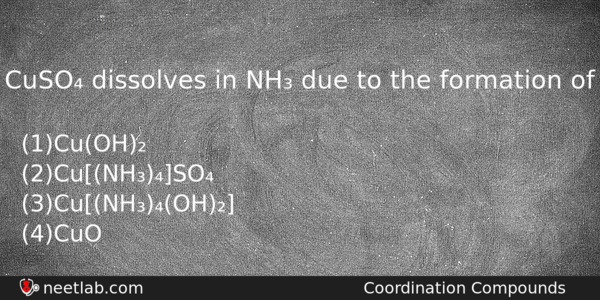| ⇦ | 
| ⇨ |
CuSO₄ dissolves in NH₃ due to the formation of
Options
(a) Cu(OH)₂
(b) Cu[(NH₃)₄]SO₄
(c) Cu[(NH₃)₄(OH)₂]
(d) CuO
Correct Answer:
Cu[(NH₃)₄(OH)₂]
Explanation:
NH₃+ H₂O→ NH₄OH
CuSO₄ + NH₄OH → Cu(OH)₂ + (NH₄)₂ SO₄ / Cu(OH)₂ + 2NH₄OH + (NH₄)₂ SO₄ → [Cu (NH₂)₄] SO₄ + 4 H₂O ( Tetrammine cupric sulphate
The complex is called as Schotzer’s reagent which is used for dissolving cellulose in the manufacture of artificial silk.
Related Questions: - Dynamite contains
- Which one of the following statements regarding photochemical smog is not correct
- Number of isomers of C₄H₁₀ is
- Which of the following is not a thermodynamic function
- The number of moles of KMnO₄ that will be needed to react with one mole of
Topics: Coordination Compounds
(87)
Subject: Chemistry
(2512)
Important MCQs Based on Medical Entrance Examinations To Improve Your NEET Score
- Dynamite contains
- Which one of the following statements regarding photochemical smog is not correct
- Number of isomers of C₄H₁₀ is
- Which of the following is not a thermodynamic function
- The number of moles of KMnO₄ that will be needed to react with one mole of
Topics: Coordination Compounds (87)
Subject: Chemistry (2512)
Important MCQs Based on Medical Entrance Examinations To Improve Your NEET Score
18000+ students are using NEETLab to improve their score. What about you?
Solve Previous Year MCQs, Mock Tests, Topicwise Practice Tests, Identify Weak Topics, Formula Flash cards and much more is available in NEETLab Android App to improve your NEET score.
Share this page with your friends

Leave a Reply